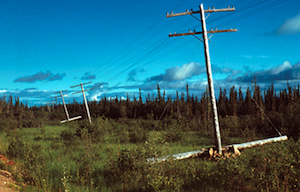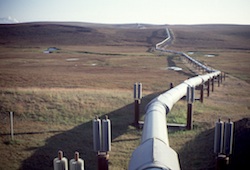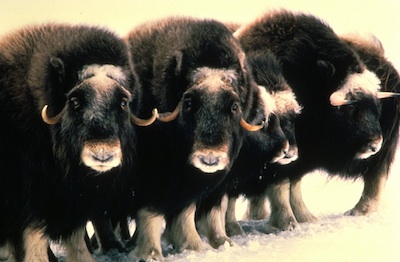|
Permafrost is a common
feature of the arctic tundra climate and biome. Permafrost refers to permanently frozen
ground. Actually, the ground has two layers which freeze. A surface layer, called the
active layer, thaws during the short "summer" and often subsides. Beneath the
active layer is the inactive layer which stays frozen throughout the year. Permafrost
creates a barrier to the rootdevelopment. Larger trees can grow along better drained
river valleys where the depth to permafrost is greater. The annual freezing and thawing
disrupts root systems inhibiting the growth of very tall vegetation. Figure 13.28 Trans-Alaska
pipeline snakes across the Alaskan tundra Permafrost creates an engineering nightmare for the construction of buildings and other structures. You can see in Figure 13.26 how telephone poles have been tilted from the heaving of the surface during freezing and thawing. Much concern for damage to the environment was raised over the construction of the Trans-Alaska Pipeline. The heated oil running though the pipeline is insulated from the cold permafrost where it runs underground. In places it zigzags over the surface on stilts that allow it to expand and contract.
The Musk Oxen is a well-known inhabitant of the arctic tundra. A dense fur coat protects them from the severe climatic conditions in the tundra. Beneath is a dense fine undercoat that is fairly waterproof. Adults gather in a protective wall to keep the calves safe from predator attacks and severe storms. Musk oxen inhabited much of Eurasia and North America during the Ice Ages, but now survive only in parts of Greenland and northern Canada.
Video: Arctic National Wildlife
Refuge
|
 Figure 13.27
Figure 13.27
 Figure 13.29 Musk
Ox of the Alaskan arctic tundra. (Courtesy: U.S. Fish
and Wildlife Service)
Figure 13.29 Musk
Ox of the Alaskan arctic tundra. (Courtesy: U.S. Fish
and Wildlife Service)